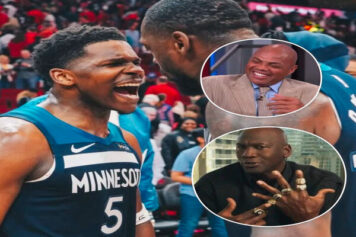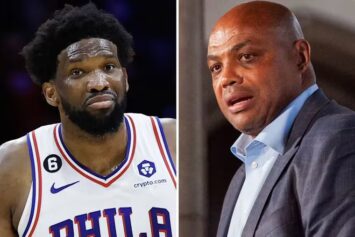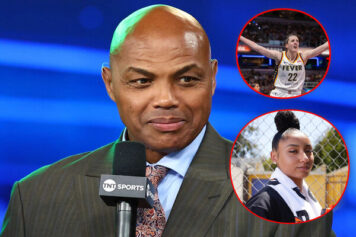Its difficult to fathom that our beloved game of basketball lost one of its shining young princes 25 years ago today. On March 4, 1990, Hank Gathers had just scored on another of his powerful tomahawk dunks with 13:34 left in the second half of Loyola-Marymounts West Coast Conference semi-final game against the University of Portland.
After a few steps, he collapsed. He attempted to get up while telling the team trainers, I dont want to lay down, before he stopped breathing. He was announced dead on arrival at a nearby hospital within a few minutes.
Every year, as we approach the conference tournaments that kick off March Madness, I take a moment to reflect back on one of my favorite college players of all time, a young man who was blessed by the basketball gods and taken from us much too soon.
I think back to that incredible brand of hoops that Hank played in the late 1980s at Loyola-Marymount, along with his childhood friend Bo Kimble, and how their synergy on the court made an everlasting impression on my basketball soul.

Eric Hank Gathers and Gregory Kevin Bo Kimble were in junior high school when they first met on the Moylan Playground at 23rd and Diamond Streets in North Philadelphia. While Bo was throwing down some nasty dunks on a rim that was a little higher than the standard 10 feet, Hank wandered over to watch.
Kimble was a regular at nearby Whittier Playground and already had a reputation as a rising star on the local hoops scene. The two young men started talking and found that they had something in common, that they lived for the feel of the ball in their hands. They immediately sensed a kindred spirit in one another.
As sunlight faded on their first meeting on the Moylan courts, Hank parted with these words All right, man, I just wanted to check out who was dunking. If you ever want some work, just come up the block. I live over there.
He nodded toward the notorious Raymond Rosen Projects, one of Phillys roughest.
Hank lived on the first floor, where it was especially bad because of street fights noise and crashing near his door, whether it was three in the morning or three in the afternoon, wrote Kimble in his book, For You, Hank. Hank grew up with all kinds of people who never made it to the age of twenty. There were four people Hank knew who all died from drug overdoses in just a few months over one summer. It was nothing to walk out in the morning and find that someone you knew, a neighbor, a friend, someone you played with only a day ago had been murdered the night before.
Kimble lived a few blocks away and also had to navigate a difficult path. These were boys with hopes and dreams, raised in one of Americas forgotten pockets of urban despair, an eyesore of blight that never appeared on postcards alongside the tourist-friendly Liberty Bell.
In the middle of one playground pick-up game, a group of Kimbles teammates sprinted off the court and chased a kid who was walking outside the park. Peering through the fence during the unexpected game-break, he witnessed someone pull out a pistol and shoot the kid in the head.
While Bo already possessed a supreme outside jumper and could dunk with authority when he was well under six-feet when they first met, Hank was merely an awkward, lithe sixth-grader known more for his relentless rebounding, work ethic and heart as opposed to his limited offensive skills.

On the court, Bo was the smooth one. And Hank was the one that nobody wanted to fight for a rebound against. He was also, among those in his inner circle, a hilarious comedian with the gift of being able to mimic anyone.
The two friends grew closer when they began playing in the same summer programs in the legendary Sonny Hill League. And it was Hank who provided the compass for Kimble, even though Bo was the young player tabbed the citys next Chosen One.
I saw in Hank this total commitment to getting what he wanted, wrote Kimble. He wanted the same thing I did: basketball. But there was nothing nothing in all those distractions and dangers in the neighborhood, nothing in his makeup that was going to keep him from getting to where he wanted to go.
The boys drew on the power of their bond to elevate one another. They laughed, fussed and fought with each other like an old married couple. And they were hell on wheels as teammates.
After polishing their skills on the citys asphalt playgrounds and refining their nuances in the Sonny Hill league against Phillys finest at the time players like Pooh Richardson, Brian and Rodney Shorter, Doug Overton and The L Train, Lionel Simmons Bo and Hank took their game to Dobbins Technical High School.
As freshman, when Hank stood 6-foot-1 and weighed 135 pounds, they played on the junior varsity. As sophomores, they made the varsity together. The summer before their junior year, Hank stretched out to 6-foot-6 as muscles began populating his once skinny frame.
With Overton transferring into Dobbins during their junior year, the Mustangs advanced to the city title game, where they ultimately lost to Pooh Richardsons Franklin High squad. As seniors in 1985, they beat Lionel Simmons Southern High School team to win the prestigious city championship, the first ever in Dobbins history, to go along with being the top ranked team in the state of Pennsylvania.
Hank and Bo proceeded off to college together, heading to Los Angeles to attend the University of Southern California. It was a symbolic and geographical shift to the land of stars, sunshine and dreams which was as far removed from their rugged North Philly upbringing as they could get.
When head coach Stan Morrison got fired at USC after their freshman year, they transferred to Loyola Marymount. After sitting out a season due to NCAA transfer rules, Hank and Bo didnt simply play well as individuals and win games.
They made an unforgettable contribution to college basketballs rich tapestry with an offensive system that became known as Gasoline on Fire. Bo and Hank were centerpieces for one of the most entertaining college basketball teams ever. Loyola Marymount ran at a frenetic pace, choked opponents with a full-court press for the entire game and scored more than Hugh Heffner at the Playboy Mansion.
Gathers became only the second player in NCAA history to lead the country in both scoring and rebounding. He averaged an incredible 33 points and 14 rebounds per game as a junior. Kimble was also a force to be reckoned with, raining threes like a tropical monsoon and attacking the rim like mixed martial artist Ronda Rousey.
But when Gathers collapsed in a game during his senior year against Santa Barbara in December of 1989 and was found to have an abnormal heartbeat, the fun suddenly turned somber. After being cleared to play again, after numerous tests and under medication, basketball fans breathed a sigh of relief when Hank returned to the basketball court, although he initially seemed to lack his trademark ferociousness.
Behind the scenes, stories circulated that he was cutting back on his medication dosage and not taking it at all on game days because it made him feel sluggish, adversely affecting his play.
One game encapsulates the breathtaking wonder of their unique contributions to college basketball, the February 3rd matchup with L.S.U. in 1990. Bo and Hanks team walked into Baton Rouge averaging 121 points per game. 121!!! That number is crazier than Pete Carrolls final play call in the Super Bowl.
But Dale Browns L.S.U. team had its own explosive weaponry in the wondrous talents of the artist formerly known Chris Jackson, Stanley Roberts, Shaquille ONeal and Vernel Singleton.
Shaq scored 20 points, snatched 24 rebounds and swatted a then-SEC record 12 blocks. Roberts did not miss one field goal attempt and finished with 19 points and 12 rebounds and Singleton had 22 points and eight rebounds.
Chris Jackson, who would later change his name to Mahmoud Abdul-Rauf, scored 34 while handing out nine assists.
Bo Kimble scored 32 points for Loyola-Marymount and Hank Gathers was a man among boys while dropping a mesmerizing 48 points on Shaq and Stanley Roberts.
Sadly, on March 4th, 1990, Hank Gathers died on the court in that game against Portland. The autopsy found that he suffered from a heart-muscle disorder known as Hypertrophic Cardiomyopathy.
He was only 23 years old, a certain NBA lottery pick who reminded many of a young Charles Barkley due to his dynamic force, strength, physicality and voracious appetite for rebounds.
And even though Hank is no longer with us, his relentless determination and hard work around the basket will never be forgotten by those who witnessed it.
Together, with that swagger, confidence, unwavering desire to succeed and hope in the unseen that was honed in North Philly, Bo and Hank formed one of the greatest shows the college game has ever seen.
Today, Gersten Pavilion, Loyola-Marymounts home court, is unofficially known as Hanks House.



